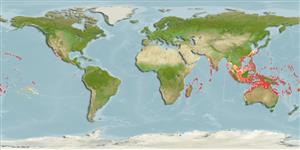Common names from other countries
>
Eupercaria/misc (Various families in series Eupercaria) >
Scaridae (Parrotfishes) > Sparisomatinae
Etymology: Calotomus: Greek, kalos, kallos = beautiful + Greek, tomos = section, cut (Ref. 45335).
More on author: Valenciennes.
Environment: milieu / climate zone / depth range / distribution range
Ecologie
marien rifbewoner; diepte 1 - 71 m (Ref. 58302). Tropical; 30°N - 31°S, 30°E - 89°W
Indo-Pacific and Eastern Pacific: widest ranging member of the genus, from East Africa to the Revillagigedo and Galapagos islands. Replaced by Calotomus viridescens in the Red Sea (Ref. 37816). Presence in Somalia to be confirmed (Ref. 30573).
Grootte / Gewicht / Leeftijd
Maturity: Lm ? range ? - ? cm
Max length : 54.0 cm TL mannelijk / geslacht onbekend; (Ref. 5490)
Dorsale stekels (totaal): 9; Dorsale zachte stralen (totaal): 10; Anale stekels 3; Anale zachte stralen: 9; Wervels: 25. Grayish brown when fresh with scales with fine whitish markings, shading to brownish red ventrally; head paler ventrally, an indistinct orange-brown line from orbit to upper lip; posterior to orbit, 3 short dull reddish lines. Flexible dorsal spines. Caudal fin rounded in juveniles, double emarginate with slightly prolonged lobes in large males. Skin black around anus. Lateral line interrupted. Brownish red pelvic fins with blotches or spots. Dull reddish-brown iris.
Inhabits subtidal reef flats, and lagoon and seaward reefs to a depths of at least 27 m (Ref. 1602). Found in coral, rubble, seagrass (Ref. 41878, 58302) and weedy areas (Ref. 9710). Benthopelagic (Ref. 58302). Found singly or in small groups (Ref. 9710). Feeds on a variety of benthic encrusting algae, e.g., Padina (Ref. 37816) and seagrasses. A protogynous hermaphrodite which may only have secondary males. Caught with nets and other types of artisanal gear.
Levenscyclus en paargedrag
Maturiteit | Voortplanting | Paaien | Eieren | Fecunditeit | Larven
Spawning observed to occur off the reef front on the falling tide at the Aldabra Atoll.
Bruce, R.W. and J.E. Randall, 1985. A revision of the Indo-West Pacific parrotfish genera Calotomus and Leptoscarus (Scaridae: Sparisomatinae). Indo-Pac. Fish. (5):32 p. (Ref. 525)
Status op de Rode Lijst van het IUCN (Ref. 130435)
CITES (Ref. 128078)
Not Evaluated
Gevaar voor de mens
Harmless
Gebruik door de mens
Visserij: commercieel; Aquarium: Commercieel
Meer informatie
ReferentiesAquacultuurAquacultuurprofielKweeklijnenGeneticaElectrophoresesErfelijkheidZiektesVerwerkingMassaconversie
Tools
Speciale rapporten
Download XML
Internetbronnen
Estimates based on models
Preferred temperature (Ref.
115969): 24.7 - 28.7, mean 27.5 (based on 664 cells).
Fylogenetische diversiteitsindex (Ref.
82804): PD
50 = 0.5312 [Uniqueness, from 0.5 = low to 2.0 = high].
Bayesian length-weight: a=0.01259 (0.01004 - 0.01578), b=3.11 (3.05 - 3.17), in cm Total Length, based on LWR estimates for this species (Ref.
93245).
Trofisch niveau (Ref.
69278): 2.0 ±0.00 se; based on food items.
Weerstandsvermogen (Ref.
120179): Gemiddeld, minimale populatieverdubbelingstijd 1,4-4,4 jaar (Preliminary K or Fecundity.).
Fishing Vulnerability (Ref.
59153): Moderate vulnerability (42 of 100).
